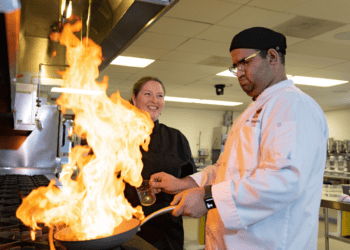Caring During COVID: Orange County’s Community College Nursing Programs Feature Story
January 30, 2021

Like different members of the same family, Orange County’s four nursing programs have a lot of things in common while being uniquely special unto themselves. Hosted at Cypress, Golden West, Saddleback, and Santa Ana Colleges, each program boasts the committed leadership of experienced directors who “earned their stripes” as registered nurses long before they entered academia, all have deep roots in their respective communities and critical relationships with regional healthcare providers, and all boast exceptional NCLEX pass rates.
At the same, each maintains its own identity as expressed by their one-of-a-kind student bodies and the unique support programs and educational pathways each offers.
Not surprisingly, the heart of these programs and their deep connection to the field of nursing is reflected in the lifetime of dedication their current directors have made to the field. Dee Oliveri, Saddleback’s assistant dean and director of nursing, started her career in 1973 and has been a nursing educator and administrator for the last 27 years. The associate dean of health sciences and director of nursing at Santa Ana College, Mary Steckler, graduated from Saddleback College with a degree in registered nursing in 1982 and went on to spend 30 years as an emergency room nurse. In 1999, while still working the ER, she entered nursing education as an instructor.
Similarly, Terri Wheeler, director of nursing for Cypress College, was a pediatric nurse for over 30 years before taking her love of the profession into the public health sector and later into nursing education in 2003. Like all of these directors, Wheeler’s love of the profession was a key motivator in her decision to enter nursing education.
“My philosophy on nursing has always been that I believe every patient deserves to be treated fairly and with respect and dignity, and to receive the best quality care possible,” says Wheeler. “When I entered nursing education, I was really trying to figure out what I could give to this profession that I loved so much and that I really feel is at the core of healthcare. If you talk to a real nurse, they’ll tell you it’s deep inside them.”
Given the ever-growing demand for nurses across Orange County and the great salaries RNs command ($110,620/year on average in California according the US Department of Labor), these community colleges receive hundreds of applications each enrollment period even though their programs only accept 40-60 new students at a time. Not surprisingly, demand is high because the quality is exceptional. All of Orange County’s community college nursing programs boast NCLEX-RN licensing exam pass rates above 90%.
Each college’s registered nursing program is an accredited, California Board of Registered Nursing-approved, two-year AS degree program that prepares students to successfully take the state licensure exam and begin a career as a registered nurse in a variety of health care settings. Nursing students take classes with both theory and clinical components and typically specialize in an area like medical-surgical, geriatric, maternal-child, mental health, and child-family nursing.
To learn more about the exceptional nursing programs at Cypress, Saddleback, and Santa Ana Colleges, please keep reading. To read about Golden West’s program, please see this article from September, “From COVID-19 to Community-Based Clinical Sites: Golden West College’s Nursing Program.”
Cypress College – Director of Nursing Terri Wheeler, MSN, RN
In your opinion, what makes your program unique?
“I think the thing that makes Cypress stand out is our reputation in the community, and that comes from having great faculty and a program that consistently turns out high-quality nurses that are ready to work. So we have that as a foundation. Part of that is because of our faculty’s willingness to go above and beyond for students. The other part is that they’re well-connected to the community and regional facilities because that’s where all of them work. This has been of critical importance during COVID because it meant that they could reach out to those entities to help us supplement clinical hours by fostering new relationships. When hospitals started letting a limited number of nursing students come back to do their clinical hours in the fall, I had directors calling me and saying they wanted to make sure that our students were able to come back. I think that says a lot.”
Are there any unique offerings or services that enhance your nursing program’s identity?
“Our Career Mobility program is unique in that it gives students who are already licensed vocational nurses (LVNs) or psychiatric technicians a way to transition into a registered nursing career with a head start. In those programs, students enter in their third semester and save a year of school. So that’s great for working professionals. But since Cypress also offers a psychiatric technician degree, it’s also a great pathway for students who apply but don’t get into our program. They can start there, get a professional degree, find work, and then apply again to the registered nursing program. That extra experience not only introduces them to the health field but also makes their applications stronger the next time around.”
Clinical placement hours have presented a significant problem to nursing programs given social distancing requirements and the fact that traditional healthcare facilities like hospitals are overloaded treating COVID patients. How has your program worked to overcome these challenges?
“As with the other colleges, telehealth has been critical to meeting our clinical hour requirements. It is really more than just a way for us to meet the clinical requirements but a way to meet a real need in this environment we find ourselves in. That’s how people are taking care of their health these days. If you need to see your doctor, you’re probably starting with a telehealth visit.
In addition to adding new community-based clinical sites, we also expanded on some existing ones—school districts being one example. Traditionally, students would visit schools in the fall to help them administer flu vaccines. But this fall, as districts were trying to figure out how to get students back on campus, our students became part of the screening staff for students. These kinds of win-win partnerships have been key.”
Santa Ana College – Interim Associate Dean of Health Sciences/Director of Nursing Mary Steckler, MSN, RN, CNE
In your opinion, what makes your program unique?
“First of all, the diversity of our student body is pretty special. We’re obviously a very Latinx community, but we also have significant numbers of Asian, African American, and Middle Eastern students. But in addition to ethnic diversity, our students span a wide range of ages from 22 to 64, with 25% of our students being male. Secondly, we’re heavily connected to our community. Without that support, I don’t know where we would be.
And the last thing I’d mention is our extended campus program with St. Joseph’s Hospital. We have a class and a skills lab there and the agreement is in addition to the 40 students in our regular program, 20 more take their classes at St. Joseph’s with 10 of those spots being reserved on a first-come-first-served basis for St. Joseph’s employees who want to become nurses.”
Are there any unique offerings that add to your nursing program’s identity?
“Our student nurses association has a great mentorship program to support one another. Fourth-year students support our first-semester students to help them be successful. We also have something called Advanced Placed, a unique program for students who were unsuccessful in another program but are ready and committed to trying again. The biggest reasons students fail is because they work too much and have trouble finding that work/life balance. To help these students succeed, we offer an extended orientation that tries to help them find that balance so they can succeed.
Also, we recently partnered with our non-credit side to create a new certified nursing assistant (CNA) program. The great thing is that it provides a ‘foot in the door’ for students that is completely free. It introduces them to the allied health field while also getting them a certificate that can get them a real job as a CNA. Then, when they’re ready, they can apply to the RN program.”
Clinical placement hours have presented a significant problem to nursing programs given social distancing requirements and the fact that traditional healthcare facilities like hospitals are overloaded treating COVID patients. How has your program worked to overcome these challenges?
“Under the guidance of the Board of Registered Nursing, we created a telehealth program which allows our students to get direct patient care hours. The majority of our faculty work clinically, so they’re connected to the communities, to the facilities, and to the workforce. Some of them had experience with telehealth which helped us immensely as we figured out how to make it work. Telehealth will play an important role in the future of healthcare, so we feel this is a great addition to our program. We were also fortunate in that the City of Santa Ana contracted with Medica to provide COVID testing using Santa Ana College as their testing site. As soon as I heard they were doing this, I reached out to Medica and said, ‘I can have 200 students to you tomorrow.’ That’s been great because students have to do assessments and health histories, and then maintain the evidence chain after actually administering the tests.”
Saddleback College – Assistant Dean of Health Sciences & Human Services/
Nursing Program Director Dee Oliveri, Ed.D., RN
In your opinion, what makes your program unique?
“First, we have amazing faculty. They’re dedicated to students, totally student-centered, and really sensitive to what students’ needs are. This has been especially apparent during the pandemic where we had to turn the program around on a dime. Because of them, we’ve been able to keep our current and new students on track to graduate on time. We know our students give up a lot and work so hard to get into these programs. Our attitude was that ‘we are not going to cave to this’ and we didn’t. They did a phenomenal job.
We also have really great support from our administration starting with the interim dean all the way up to our president. With all of the facilities and waiver issues, they’ve stepped in to advocate for the program and the students. It makes a difference when your leadership doesn’t just say students are important, but makes the effort to show students they are.”
Are there any unique career pathways or program offerings that add to your nursing program’s identity?
“We just piloted a new certified nursing assistant (CNA) program in the fall. Because it’s non-credit, it’s free to anyone who wants to take it but gives students a chance to earn a state-approved certificate that leads to real job as a certified nursing assistant. It’s just one class and about 120 clinical hours. On the credit side, we also have a medical assisting program that gives students another pathway into the allied health field while also getting them one step closer to becoming a nurse if they choose to apply. Our programs are very competitive, so sometimes it’s nice for students to have options that lead to real jobs but keep them on the path to becoming an RN.”
Clinical placement hours have presented a significant problem to nursing programs given social distancing requirements and the fact that traditional healthcare facilities like hospitals are overloaded treating COVID patients. How has your program worked to overcome these challenges?
“Like our sister programs across the region, we’ve had to get creative. We’ve added a significant telehealth component that gives students direct patient hours. Saddleback also has an excellent student health center that offers mental health services, so nursing students focusing on that area have been able to get experience under the supervision of faculty and licensed therapists. For students focusing on pediatrics, we found preschools and school systems that were willing to have us there. Our community respects our program and our faculty and I think that has really opened the doors of these alternative sites.
It’s important that we have a program that reflects what it’s like in the work world when our students graduate, and the truth is, patients aren’t just in hospitals these days. They’re out in the community—that’s where healthcare is. I think we understand that better now and our program reflects that reality.”




